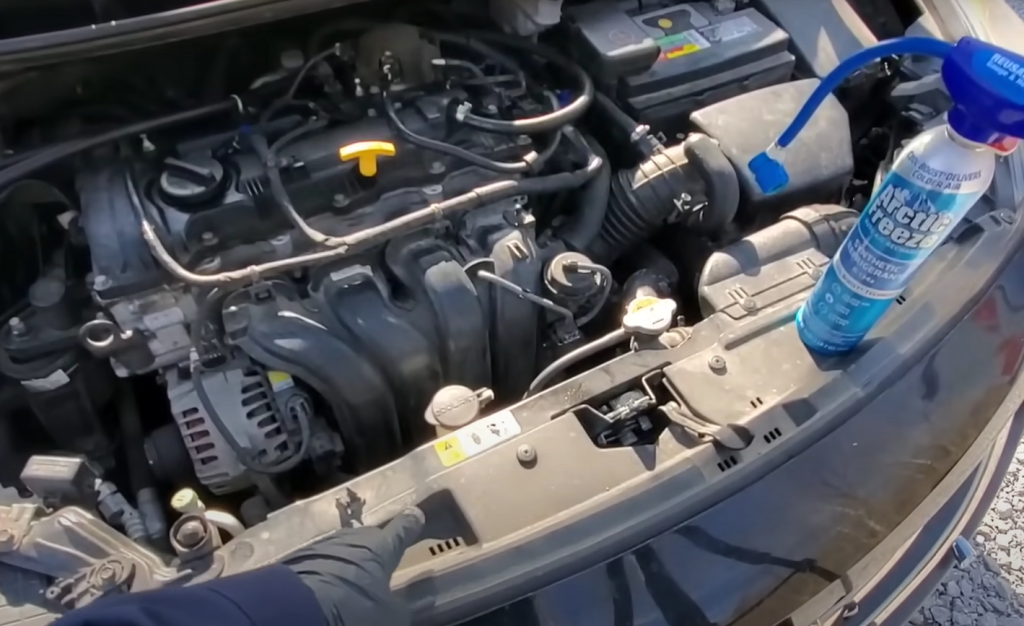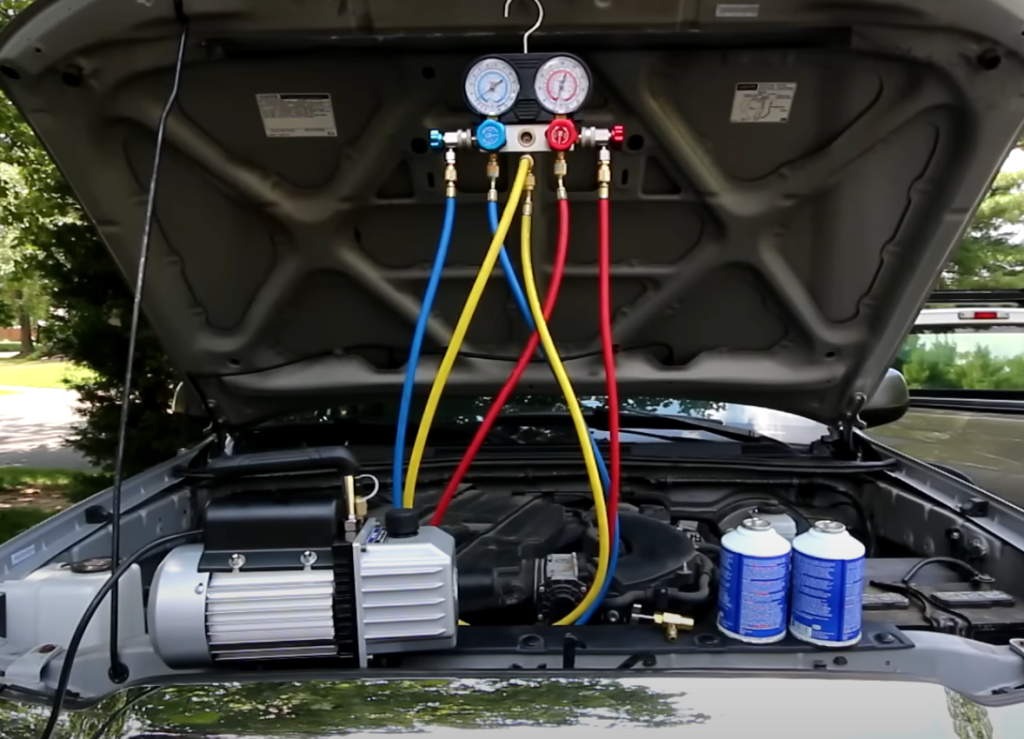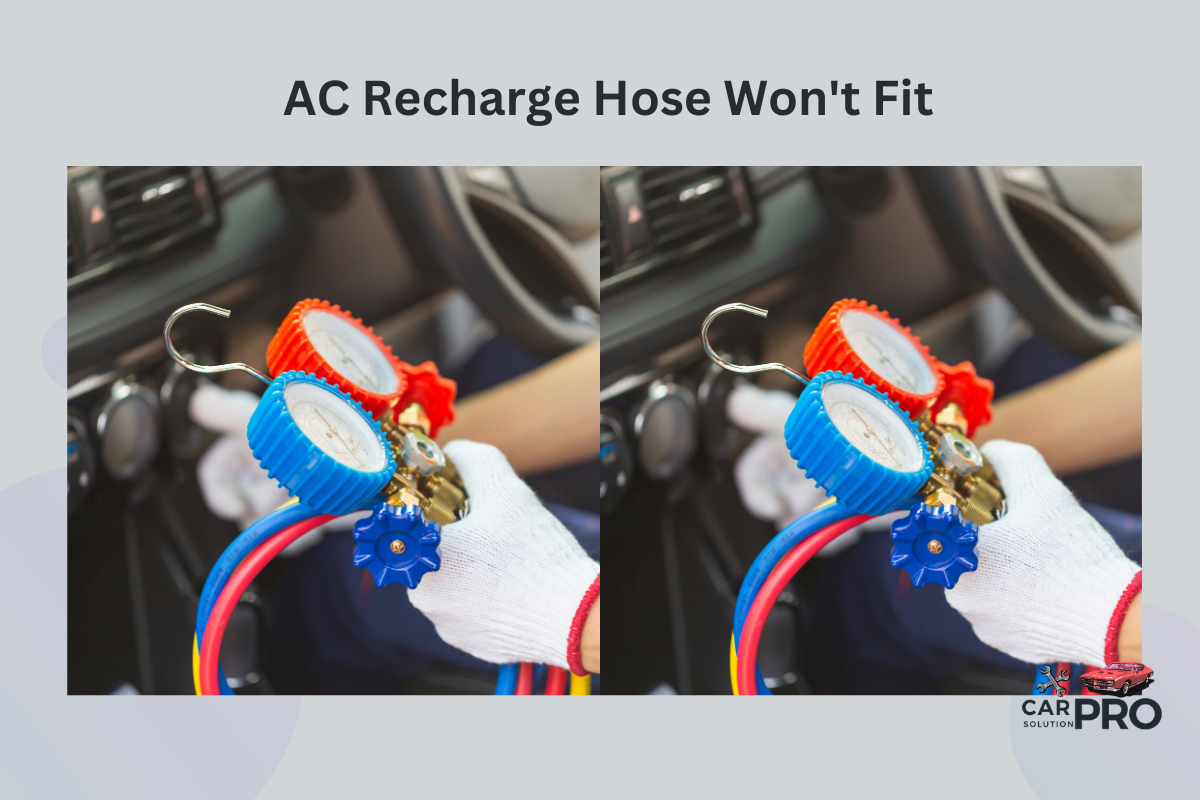Car AC problems can be frustrating, especially when you’re trying to recharge the system yourself. One common issue is when the AC recharge hose won’t fit properly. This can happen for various reasons, from using the wrong type of hose to problems with the car’s AC system itself.
The most frequent causes of an AC recharge hose not fitting are using the wrong port, a faulty connector, or forgetting to pull back the locking ring on the hose. If you’re facing this problem, don’t worry – there are solutions. It’s important to check that you’re using the correct low pressure port and not mistakenly trying to connect to the high pressure port.
Sometimes, the issue may be with the AC components themselves. A non-functioning compressor or a faulty connector can prevent the hose from fitting properly. In these cases, it’s best to have a professional mechanic inspect your AC system to identify and fix any underlying problems.
Key Takeaways
- AC recharge hoses may not fit due to wrong port selection, faulty connectors, or user error
- Properly identifying the low pressure port and checking for AC system issues can help resolve fitting problems
- Professional inspection may be necessary if DIY troubleshooting doesn’t solve the issue
Understanding AC Recharge Hoses
AC recharge hoses are crucial for maintaining your car’s air conditioning system. These hoses connect refrigerant cans to your vehicle’s AC system, allowing you to refill low refrigerant levels.
Components of an AC Recharge Hose
An AC recharge hose has several key parts:
- Coupler: This attaches to the low-pressure port on your car’s AC system.
- Valve: Controls refrigerant flow from the can into the system.
- Gauge: Measures pressure in the AC system during recharging.
- Trigger: Releases refrigerant when pressed.
The hose itself is made of durable, flexible material that can withstand high pressure. It’s designed to prevent leaks and ensure a secure connection.
Types of AC Recharge Hose Fittings
Different cars use various AC recharge hose fittings. The most common types are:
- R-134a: Used in most modern vehicles.
- R-12: Found in older cars (pre-1994).
- Quick-connect: A newer, easier-to-use fitting.
It’s crucial to use the correct fitting for your car’s AC system. Using the wrong type can lead to connection issues or system damage.
Some recharge kits come with adapters to fit multiple systems. Always check your car’s manual or consult a mechanic to ensure you have the right fitting.
Common Issues with AC Recharge Hoses

AC recharge hoses can encounter problems that prevent proper fitting and function. These issues often stem from size mismatches or damage to key components.
Mismatched Hose and Port Sizes
AC recharge hoses may not fit due to incompatibility between the hose and the vehicle’s low-pressure port. Different car models use various port sizes, so a one-size-fits-all approach doesn’t work.
To avoid this issue, always check the hose’s compatibility with your specific vehicle make and model. Some newer cars have smaller ports that require special adapters.
If the hose is too large, it won’t connect properly. Conversely, a hose that’s too small can’t form a secure seal. This can lead to refrigerant leaks or incomplete recharging.
Damaged Seals and Threads
Wear and tear on the hose or port can cause fitting problems. Damaged threads on either the hose or port make it hard to achieve a tight connection.
Rubber seals on the hose can dry out, crack, or degrade over time. This compromises their ability to form an airtight seal. Inspect seals regularly and replace the hose if you notice any damage.
Dirt or debris in the port can also prevent a proper fit. Clean the port carefully before attempting to connect the recharge hose. Use compressed air or a soft brush to remove any contaminants.
If the lock ring on the hose isn’t pulled up, it won’t snap over the port correctly. Always check that the lock mechanism is engaged when connecting the hose.
Properly Attaching AC Recharge Hoses
Connecting AC recharge hoses correctly is key for a successful refrigerant top-up. The right tools and steps help avoid leaks and ensure a proper seal.
Checking Hose and Port Compatibility
Before attaching the hose, check that it matches your car’s AC system. Look for the low-pressure port on your AC. It’s usually larger than the high-pressure port and has a different connector shape.
Make sure the hose fitting matches the port size and style. Some cars need special adapters. If the hose won’t fit, don’t force it. You might have the wrong type.
Check that the port cap is clean and undamaged. Remove any dirt or debris. A damaged cap can cause a bad connection.
Step-By-Step Connection Process
- Start the engine and turn on the AC to maximum cool.
- Locate the low-pressure port and remove its cap.
- Pull back the locking ring on the hose coupler if it has one.
- Line up the hose with the port carefully.
- Push the coupler onto the port firmly.
- Release the locking ring to secure the connection.
Listen for a click as the coupler locks in place. Gently tug the hose to check it’s secure. If it comes off, try again. Make sure the car’s AC compressor is running during this process.
Troubleshooting Connection Problems
When an AC recharge hose doesn’t fit properly, it can be due to cross-threading or worn seals. These issues can prevent a secure connection and lead to refrigerant leaks.
Resolving Cross-Threading Issues
Cross-threading happens when the threads on the hose and port don’t align correctly. To fix this:
- Inspect the threads on both the hose and port for damage.
- Clean the threads with a wire brush to remove dirt or debris.
- Align the hose carefully before attaching.
- Turn the hose counterclockwise until you feel a slight drop, then start turning clockwise.
If the hose still won’t fit, try a different quality AC recharge hose. Sometimes, poor manufacturing can cause fitting problems.
Seal Replacement Techniques
Worn or damaged seals can prevent a proper connection. To replace the seals:
- Remove the old seal using needle-nose pliers.
- Clean the seal area thoroughly.
- Apply a small amount of refrigerant oil to the new seal.
- Insert the new seal carefully, making sure it’s seated properly.
Check the quick connector’s lock ring before attaching the hose. Pull it up to allow the hose to snap onto the port. If problems persist, consider having a professional inspect the AC system.
Safety Measures and Best Practices
When dealing with AC recharge hoses, it’s crucial to follow proper safety protocols and best practices. This helps protect you from potential hazards and ensures the integrity of your vehicle’s AC system.
Proper Handling of Refrigerants
Refrigerants can be dangerous if not handled correctly. Always wear safety glasses and gloves when working with AC systems. Avoid skin contact with refrigerants, as they can cause frostbite. Work in a well-ventilated area to prevent inhaling harmful fumes.
Never mix different types of refrigerants. This can damage the AC system and create hazardous chemical reactions. Check your vehicle’s manual to identify the correct refrigerant type.
Follow local regulations for refrigerant disposal. Many areas require professional disposal due to environmental concerns. Never release refrigerants into the atmosphere.
Avoiding Contamination and Damage
Keep all AC components clean and free from debris. Even small particles can cause significant damage to the system. Use protective caps on ports when not in use to prevent contamination.
Check for compatibility between the recharge hose and your vehicle’s AC system. Using the wrong type of hose can lead to leaks or system damage. Ensure the hose is properly connected before adding refrigerant.
Avoid overcharging the system. Use a pressure gauge to monitor refrigerant levels and stop when the recommended pressure is reached. Overcharging can reduce cooling efficiency and potentially damage the compressor.
Frequently Asked Questions
AC recharge hoses can be tricky to connect properly. Common issues include incompatible fittings, incorrect port identification, and the need for adapters. Understanding these problems helps car owners troubleshoot and find solutions.
Why won’t my AC recharge hose connect to the low pressure port?
The AC recharge hose may not connect due to incompatible fittings. Different car models use various types of ports. The hose might be designed for a different system or require an adapter.
Another reason could be a damaged or dirty port. Debris or corrosion can prevent a proper seal. Inspect the port for any visible issues before attempting to connect the hose.
How can I tell if I need an adapter for my AC recharge hose?
To determine if an adapter is needed, check the car’s manual for AC port specifications. Compare this information to the fitting on the recharge hose.
If the hose doesn’t fit snugly, an adapter is likely required. Auto parts stores often have fitting guides to help identify the correct adapter for specific car models.
What steps should I follow to properly attach a recharge hose to my vehicle’s AC system?

First, locate the low pressure port. It’s usually labeled and has a protective cap. Remove the cap and clean the port if necessary.
Align the recharge hose fitting with the port. Push firmly and listen for a click, indicating a secure connection. If it doesn’t fit easily, stop and check for compatibility issues.
Can the size of AC port fittings vary, and how do I identify the right size for my car?
AC port fittings do vary in size between different car makes and models. To identify the right size, consult the vehicle’s manual or look up the specifications online.
Measuring the port diameter can also help. Use calipers for accuracy. Common sizes include 8mm, 10mm, and 12mm, but there are others.
What should I do if my AC recharge hose with gauge is not fitting?
If the hose with gauge doesn’t fit, first double-check that you’re connecting to the correct port. The low pressure port is typically larger than the high pressure port.
Inspect the hose fitting for damage. If it’s bent or worn, it may not connect properly. Consider trying a different brand of recharge kit or seeking professional help.
Is there a universal fitting for car AC recharge hoses, or do I need a specific type for my car?
There isn’t a truly universal fitting for all cars. However, many recharge kits come with multiple adapters to fit various vehicles.
For older cars, R-12 systems use different fittings than modern R-134a systems. Always check the refrigerant type and fitting size for your specific car model before purchasing a recharge kit.


